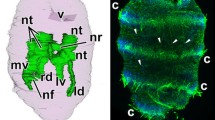Abstract
Nephridial diversity is high in Phyllodocida (Annelida) and ranges from protonephridia to metanephridia. The nephridia of Tomopteris helgolandica (Tomopteridae) can be characterized as metanephridia which bear a multiciliated solenocyte. This cell is medially apposed to the proximal part of the nephridial duct and bears several cilia, each of which is surrounded by a ring of 13 microvilli. An extracellular matrix connects the microvilli and thus leads to the impression of a tube surrounding the central cilium. Each tube separately enters a subjacent duct cell and the cilia extend into a cup-shaped compartment within the duct cell. This compartment is not connected to the duct. The funnel consists of eight multiciliated cells and is connected to the nephridial duct, which initially runs intercellularly and later percellularly. The last duct cell bears a neck-like process which pierces the subepidermal basal membrane and is connected to epidermal cells forming a small invagination, the nephropore. The nephridia of T. helgolandica develop from a band of cells and all structural components are differentiated at an early developmental stage. Further development is characterized by enlargment of the funnel, ciliogenesis in the solenocyte, merging of different sections of the duct and, finally, the formation of the nephropore. An evaluation of the nephridia of T. helgolandica leads to the hypothesis that the nephridial diversity in Phyllodocida can be explained by the retainment of different stages in the transition of protonephridia into metanephridia; this is caused by the formation of a ciliated funnel at different ontogenetic stages. Although the protonephridia in Phyllodocida are regarded as primary nephridial organs, protonephridia are also presumed to have evolved secondarily in progenetic interstitial species of the Annelida by an incomplete differentiation of the nephridial anlage.
Similar content being viewed by others
Author information
Authors and Affiliations
Additional information
Accepted: 18 December 1996
Rights and permissions
About this article
Cite this article
Bartolomaeus, T. Structure and development of the nephridia of Tomopteris helgolandica (Annelida). Zoomorphology 117, 1–11 (1997). https://doi.org/10.1007/s004350050024
Issue Date:
DOI: https://doi.org/10.1007/s004350050024




